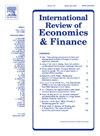Unveiling low productivity premium: A tale from emerging market
IF 4.8
2区 经济学
Q1 BUSINESS, FINANCE
引用次数: 0
Abstract
This study investigates how firm-level productivity, measured by total factor productivity (TFP), is priced in cross-sectional stock returns in China, which is the largest emerging market as well as the global manufacturing hub. We document a significant low productivity premium with an annualized return of 6.6 %, where firms with lower productivity earn higher returns compared to their higher counterparts. Low productivity firms are characterized by small size, low value, weak current profitability, illiquidity, high earnings, and idiosyncratic volatility. The low productivity premium phenomenon is robust based on comprehensive sets of empirical models and even after controlling for conventional risk factors and alternative firm characteristics. We further explore potential explanations for the low productivity premium and find that the phenomenon is primary driven by mispricing associated with arbitrage limits. Our results extend the asset pricing literature by highlighting the distinct dynamics of production-based premium in emerging markets, providing novel insights for academics, regulators, and investors interested in understanding the return predictability in immature emerging market.
揭示低生产率溢价:一个来自新兴市场的故事
本研究探讨了以全要素生产率(TFP)衡量的企业生产率如何在中国的横截面股票回报中定价。中国是最大的新兴市场,也是全球制造业中心。我们记录了一个显著的低生产率溢价,年化回报率为6.6%,其中生产率较低的公司比生产率较高的公司获得更高的回报。低生产率企业的特点是规模小、价值低、当前盈利能力弱、流动性差、高收益和特殊波动性。基于综合的经验模型集,甚至在控制了传统风险因素和替代企业特征之后,低生产率溢价现象仍然是稳健的。我们进一步探讨了低生产率溢价的潜在解释,发现这种现象主要是由与套利限制相关的错误定价驱动的。我们的研究结果通过强调新兴市场中基于生产的溢价的独特动态,扩展了资产定价文献,为学者、监管机构和对理解不成熟新兴市场的回报可预测性感兴趣的投资者提供了新颖的见解。
本文章由计算机程序翻译,如有差异,请以英文原文为准。
求助全文
约1分钟内获得全文
求助全文
来源期刊
CiteScore
7.30
自引率
2.20%
发文量
253
期刊介绍:
The International Review of Economics & Finance (IREF) is a scholarly journal devoted to the publication of high quality theoretical and empirical articles in all areas of international economics, macroeconomics and financial economics. Contributions that facilitate the communications between the real and the financial sectors of the economy are of particular interest.

 求助内容:
求助内容: 应助结果提醒方式:
应助结果提醒方式:


